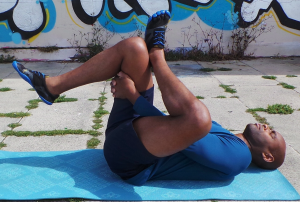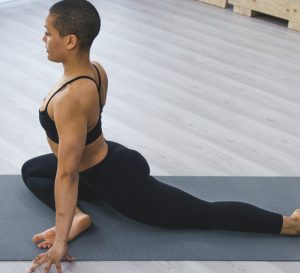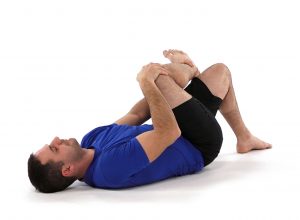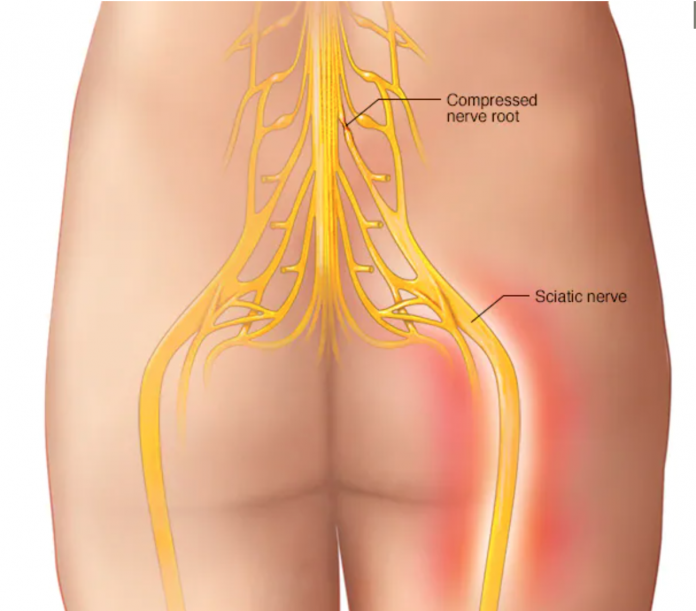Sciatic nerve pain can be so excruciating and debilitating that you don’t even want to get off the couch. Common causes of sciatica can include a ruptured disk, a narrowing of the spine canal (called spinal stenosis), and injury.
Certified physical therapist Mindy Marantz says that sciatica pain can occur for a variety of reasons. She says, “Identifying what doesn’t move is the first step toward solving the problem.” Often, the most problematic body parts are the lower back and hips.
Dr. Mark Kovacs, a certified strength and conditioning specialist, adds that the best way to alleviate most sciatica pain is to do “any stretch that can externally rotate the hip to provide some relief.”
Here are six exercises that do just that:(Note: Consult a doctor or health professional before beginning an exercise regime)
- reclining pigeon pose
- sitting pigeon pose
- forward pigeon pose
- knee to opposite shoulder
- sitting spinal stretch
- standing hamstring stretch

Pigeon pose is a common yoga pose. It works to open the hips. There are multiple versions of this stretch. The first is a starting version known as the reclining pigeon pose. If you’re just starting your treatment, you should try the reclining pose first.
- While on your back, bring your right leg up to a right angle. Clasp both hands behind the thigh, locking your fingers.
- Lift your left leg and place your right ankle on top of the left knee.
- Hold the position for a moment. This helps stretch the tiny piriformis muscle, which sometimes becomes inflamed and presses against the sciatic nerve, causing pain.
- Do the same exercise with the other leg.
Once you can do the reclining version without pain, work with your physical therapist on the sitting and forward versions of pigeon pose.
- Sit on the floor with your legs stretched out straight in front of you.
- Bend your right leg, putting your right ankle on top of the left knee.
- Lean forward and allow your upper body to reach toward your thigh.
- Hold for 15 to 30 seconds. This stretches the glutes and lower back.
- Repeat on the other side.

- Kneel on the floor on all fours.
- Pick up your right leg and move it forward on the ground in front of your body. Your lower leg should be on the ground, horizontal to the body. Your right foot should be in front of your left knee while your right knee stays to the right.
- Stretch the left leg out all the way behind you on the floor, with the top of the foot on the ground and toes pointing back.
- Shift your body weight gradually from your arms to your legs so that your legs are supporting your weight. Sit up straight with your hands on either side of your legs.
- Take a deep breath. While exhaling, lean your upper body forward over your front leg. Support your weight with your arms as much as possible.
- Repeat on the other side.

This simple stretch helps relieve sciatica pain by loosening your gluteal and piriformis muscles, which can become inflamed and press against the sciatic nerve.
- Lie on your back with your legs extended and your feet flexed upward.
- Bend your right leg and clasp your hands around the knee.
- Gently pull your right leg across your body toward your left shoulder. Hold it there for 30 seconds. Remember to pull your knee only as far as it will comfortably go. You should feel a relieving stretch in your muscle, not pain.
- Push your knee so your leg returns to its starting position.
- Repeat for a total of 3 reps, then switch legs.

Sciatica pain is triggered when vertebrae in the spine compress. This stretch helps create space in the spine to relieve pressure on the sciatic nerve.
- Sit on the ground with your legs extended straight out with your feet flexed upward.
- Bend your right knee and place your foot flat on the floor on the outside of your opposite knee.
- Place your left elbow on the outside of your right knee to help you gently turn your body toward the right.
- Hold for 30 seconds and repeat three times, then switch sides.

This stretch can help ease pain and tightness in the hamstring caused by sciatica.
- Place your right foot on an elevated surface at or below your hip level. This could be a chair, ottoman, or step on a staircase. Flex your foot so your toes and leg are straight. If your knee tends to hyperextend, keep a slight bend in it.
- Bend your body forward slightly toward your foot. The further you go, the deeper the stretch. Don’t push so far that you feel pain.
- Release the hip of your raised leg downward as opposed to lifting it up. If you need help easing your hip down, loop a yoga strap or long exercise band over your right thigh and under your left foot.
- Hold for at least 30 seconds, then repeat on the other side.
Kovacs emphasizes that you shouldn’t assume that you’ll be as flexible as the exercises ideally call for. “Don’t think that because of what you see on YouTube or TV that you can get into these positions,” he says. “Most people who demonstrate the exercises have great flexibility and have been doing it for years. If you have any kind of pain, you should stop.”
Corina Martinez, a physical therapist at Duke Sports Medicine Center and member of the American Medical Society for Sports Medicine, says that there’s no one-size-fits-all exercise for people who have sciatic nerve pain.
She suggests adjusting the positions slightly, such as pulling your knees in more or less, and noticing how they feel. “If one feels better, that is the treatment you want to pursue,” she advises.
Martinez says that anyone experiencing even mild sciatic nerve pain for more than a month should see a doctor or physical therapist. They may find relief with an in-home exercise program tailored specifically to their pain.
You can custom design and tailor core specific workouts that you can do at home right here
What are the risk factors for sciatica?
You are at greater risk of sciatica if you:
- Have an injury/previous injury: An injury to your lower back or spine puts you at greater risk for sciatica.
- Live life: With normal aging comes a natural wearing down of bone tissue and disks in your spine. Normal aging can put your nerves at risk of being injured or pinched by the changes and shifts in bone, disks and ligaments.
- Are overweight: Your spine is like a vertical crane. Your muscles are the counterweights. The weight you carry in the front of your body is what your spine (crane) has to lift. The more weight you have, the more your back muscles (counterweights) have to work. This can lead to back strains, pains and other back issues.
- Lack a strong core: Your “core” are the muscles of your back and abdomen. The stronger your core, the more support you’ll have for your lower back. Unlike your chest area, where your rib cage provides support, the only support for your lower back is your muscles.
- Have an active, physical job: Jobs that require heavy lifting may increase your risk of low back problems and use of your back, or jobs with prolonged sitting may increase your risk of low back problems.
- Lack proper posture in the weight room: Even if you are physically fit and active, you can still be prone to sciatica if you don’t follow proper body form during weight lifting or other strength training exercises.
- Have diabetes: Diabetes increases your chance of nerve damage, which increases your chance of sciatica.
- Have osteoarthritis: Osteoarthritis can cause damage to your spine and put nerves at risk of injury.
- Lead an inactive lifestyle: Sitting for long period of time and not exercising and keeping your muscles moving, flexible and toned can increase your risk of sciatica.
- Smoke: The nicotine in tobacco can damage spinal tissue, weaken bones, and speed the wearing down of vertebral disks.
How to Ease Sciatica Without Surgery
Overview
Sciatica describes pain that radiates down the back of the thigh and into the lower leg. It may be caused by irritation of one or more of the lower spinal nerves. The pain can be mild or severe, and often develops as a result of wear and tear on the lower spine. The good news is that sciatica is most often relieved through conservative methods within a matter of weeks and without requiring surgery. Working to improve your back and core strength while increasing flexibility throughout your hips and lower body will significantly reduce your chances of experiencing lower back pain and other symptoms of sciatica.
Symptoms
The symptoms of sciatica can vary from a mild ache to excruciating pain that radiates along the pathway of your sciatic nerve, which runs from your lower back down past your hips and into each leg. These symptoms can include numbness, tingling sensations, or muscle weakness that travels down the back of your thigh and into your calf or foot. It’s often worse with coughing or sneezing. Typically, people affected with sciatica will experience symptoms on only one side of the body. Although the pain may be severe, sciatica can most often be relieved through physical therapy, chiropractic and massage treatments, improvements in strength and flexibility, and the application of heat and ice packs.
Risk factors
There are many factors that can leave you susceptible to sciatica, which affects both athletes and those who are less active. People who lead a sedentary lifestyle are more likely to develop sciatica than active people. However, endurance athletes are also prone to experiencing sciatica from overworked and stiff muscles.
Age is also a significant factor, as those between the ages of 30 and 60 often experience age-related degeneration in their spine, including herniated disks, bone spurs, and joint dysfunction in the hips. Obesity and diabetes are other common contributors, according to the Mayo Clinic.
A physical therapist can help you to determine whether sciatica can be relieved through conservative methods such as chiropractic adjustments, static stretching, and cold therapy. Most people respond well to simple techniques and are pain-free within a matter of weeks. Chiropractic adjustments and massage therapy may help improve the alignment of your spine and address other underlying conditions while also improving blood circulation and muscle relaxation. Minor pain can also be treated with the application of heat and cold.
While some doctors may recommend surgery as a treatment for sciatica after noninvasive measures have failed, experts say it’s not always the right choice for everyone. In fact, according to the Cleveland Clinic, nearly 50 percent of people with sciatica report their symptoms improving within 1.5 months of their diagnosis. Nonsurgical treatments may include a longer period of recovery. However, surgery comes with its own risks, which include infection and blood clots. It’s important to talk with your doctor about your sciatica to determine which treatment is best for you.
The musculature around your spine and abdomen may be weak or overly tight, preventing it from supporting your body as needed. Poor posture and compromised muscles can impact the alignment of your spine, increasing your risk for lower back pain and sciatica. Gentle strengthening exercises that target your core and back will improve your posture and ability to respond to stress, reducing the likelihood and severity of back pain. While you’re recovering from sciatica, you may want to avoid high-impact exercises, such as running and plyometrics.
Create your own custom designed, core focused workouts, right here.
Stiff hamstrings, glutes, and hips can alter your posture and increase the stress on your lower back, which may contribute to sciatica. Most types of sciatica will benefit significantly from a stretching routine that targets the hips and hamstrings and relieves an overused or inflamed piriformis muscle. The piriformis is a small muscle that attaches at the base of the spine and runs just above the sciatic nerve. Prolonged inactivity or sitting compresses the piriformis over the sciatic nerve, which can lead to aggravation and pain. Reverse the effects of tight hips and hamstrings by adopting a simple stretching routine or incorporating yoga into your overall fitness regimen.
Here are two ways to stretch your piriformis muscle and relieve pain.
Stretch 1
- Lie on your back with both of your knees bent and your feet on the ground.
- Lift one leg and cross it just above your knee.
- Hold the thigh of the leg with the foot on the ground and pull up to your chest until you can feel the stretch in your buttocks.
- Hold for 10 to 30 seconds.
- Repeat on the opposite side.
Stretch 2
- Lie on your back with both legs straight out.
- Hold one knee with your opposite hand and pull your knee up and over to the opposite shoulder.
- Hold for 10 to 30 seconds.
- Repeat on the opposite side.
Many home remedies can be used with traditional back pain treatments. If you have questions about these, talk with your doctor.
Heat/ice therapy
Ice packs may relieve discomfort and help lessen inflammation in acute phases of back pain. Note: Don’t apply the ice directly to your skin. Wrap it in a thin towel or gauze to prevent damage to your skin.
Warm compresses may also relieve pain when inflammation has subsided. Consider alternating between heat and cold.
Exercises
Exercises to improve posture and strengthen the muscles of the back and abdominal muscles — called the core muscles — are a treatment option that should be strongly considered.
This treatment often involves:
- improving posture
- using proper lifting techniques
- strengthening core muscles
- stretching muscles to improve flexibility
*Click here to start improving you core strength for free today











Heya i am for the first time here. I came across this board and I find It really useful & it helped me out much. I hope to give something back and help others like you helped me.
Howdy! I could have sworn I’ve been to this website before but after browsing through some of the post I realized it’s new to me. Anyhow, I’m definitely delighted I found it and I’ll be bookmarking and checking back frequently!
fantastic points altogether, you just received a brand new reader. What could you suggest about your publish that you made a few days ago? Any positive?
Normally I do not read article on blogs, but I would like to say that this write-up very forced me to try and do so! Your writing style has been surprised me. Thanks, very nice post.
I抦 impressed, I must say. Actually not often do I encounter a weblog that抯 both educative and entertaining, and let me tell you, you may have hit the nail on the head. Your concept is outstanding; the problem is one thing that not sufficient individuals are speaking intelligently about. I’m very completely satisfied that I stumbled across this in my seek for something relating to this.
Comments are closed.